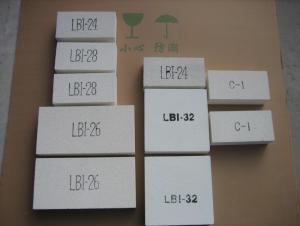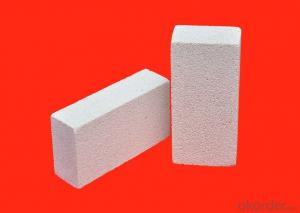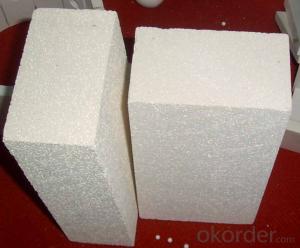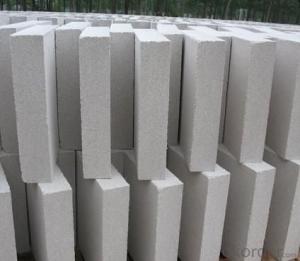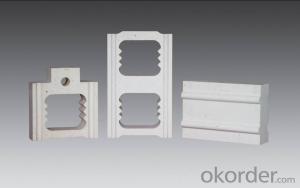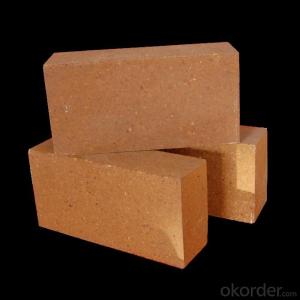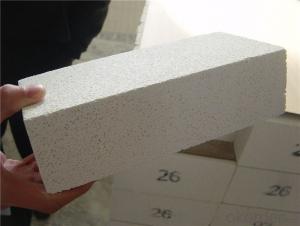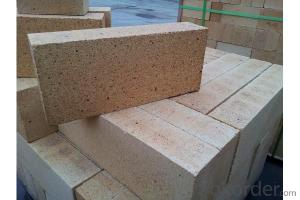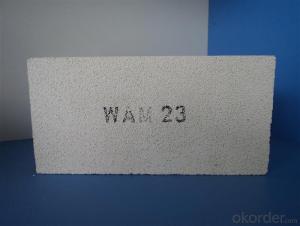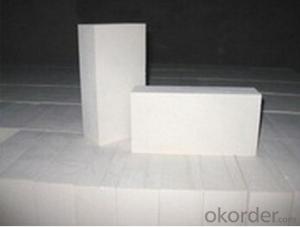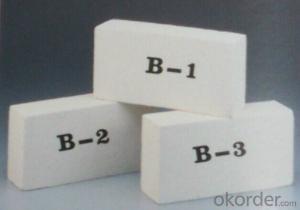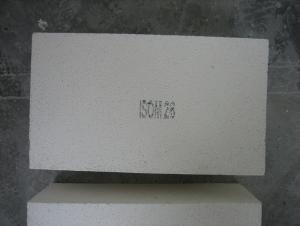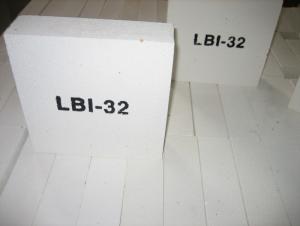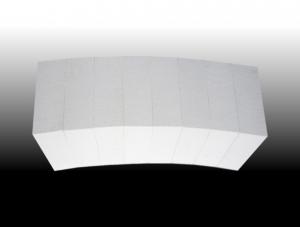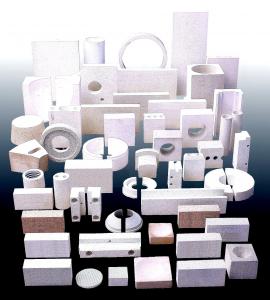Insulating Fire Brick - Refractory Mullite Insulating Refractory Brick JM 24
- Loading Port:
- Shanghai
- Payment Terms:
- TT OR LC
- Min Order Qty:
- 20 m.t.
- Supply Capability:
- 20 m.t./month
OKorder Service Pledge
OKorder Financial Service
You Might Also Like
Okorder series heat insulation brick
Okorder series thermal insulation brick is an effective, energy saving, low carbon, environmental protection advanced, according to the ASTM standard manufacturing products. Okorder series products have all kinds of materials in the field of metallurgy, industrial furnaces, aluminum, the best Li Ning petrochemical and insulation, electric power and glass ceramics. They can be used as part of an insulation or not to melt. Products have been widely used in the following furnace, achieved satisfactory results.
Application of heat preservation brick
Metallurgical Industry: blast furnace, hot blast furnace, heating furnace, etc..
Petrochemical Industry: ethylene cracking furnace, hydrogen furnace, the main furnace, heating furnace, etc..
Ceramic industry: roller kiln, kiln, etc..
Glass industry: glass furnace regenerator, etc.
Carbon industry: carbon furnace, etc..
Aluminum electrolysis industry: aluminum reduction cell, etc.
Other industries: tunnel kiln, shuttle kiln, etc..
Advantages of heat insulation brick
Low thermal conductivity: many air holes will bring good thermal insulation effect, energy saving.
High crushing strength: high crushing strength, volume stability.
Low heat storage: small heat storage, absorb more heat, energy-saving effect is obvious.
Chundu: High-speed Rail, low content of alkali metal impurities.
Accuracy: the size of the brick machining precision, cutting and grinding the special shape, speed up the brick.
Technical Data
ITEM | GJM30 | GJM28 | GJM26 | GJM23 |
Classification Temperature, ℉/℃ | 3000/1650 | 2800/1540 | 2600/1430 | 2300/1260 |
Bulk Density,g/cm³ | ≤1.0 | ≤0.9 | ≤0.8 | ≥0.5 |
Reheating Linear Change, % | ≤0.9 (1550℃,12 h) | ≤0.8 (1510℃,12 h) | ≤0.7 (1410℃,12 h) | ≤0.5 (1230℃,12 h) |
Al2O3 Content, % | ≥75 | ≥65 | ≥55 | ≥45 |
Fe2O3 Content, % | ≤0.5 | ≤0.6 | ≤0.7 | ≤1.0 |
Thermal Conductivity: | ||||
800℃, w/m.k | ≤0.39 | ≤0.37 | ≤0.35 | ≤0.18 |
1000℃, w/m.k | ≤0.43 | ≤0.41 | ≤0.39 | ≤0.20 |
1200℃, w/m.k | ≤0.48 | ≤0.46 | ≤0.43 | --- |
Insulating brick
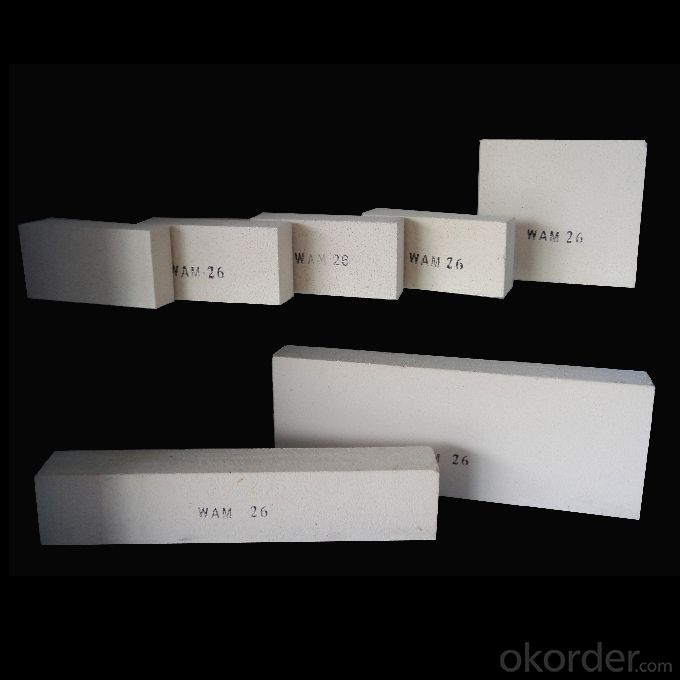
- Q: How do insulating fire bricks compare to other types of refractory materials?
- IFBs, or insulating fire bricks, are refractory materials specially designed for their high insulating properties. They have several advantages when compared to standard fire bricks or castable refractories. First and foremost, IFBs have lower thermal conductivity than other refractory materials. This means they are more effective at preventing heat loss and providing insulation for high-temperature applications. Their low thermal conductivity allows them to retain heat within furnaces or kilns, resulting in reduced energy consumption and improved efficiency. Additionally, IFBs are lightweight, making them easier to handle, transport, and install. Their lightweight nature also reduces the overall weight of the refractory lining, which can be advantageous in certain situations. Another benefit of IFBs is their ability to withstand rapid temperature changes. They exhibit good thermal shock resistance, meaning they can endure sudden temperature fluctuations without cracking or spalling. This property is particularly valuable in applications with frequent heating and cooling cycles. Furthermore, IFBs possess a high level of chemical resistance. They can withstand corrosive environments and chemical attacks, making them suitable for various applications involving acids, alkalis, and other aggressive substances. However, IFBs do have limitations. Their lower density compared to standard fire bricks means they are less durable and have lower mechanical strength. Therefore, they might not be suitable for applications that require high load-bearing capacity or are prone to heavy abrasion. To summarize, IFBs offer excellent thermal insulation, lightweight properties, good thermal shock resistance, and high chemical resistance. Nonetheless, their lower density and reduced mechanical strength may restrict their usage in certain scenarios. It is crucial to carefully consider the specific requirements of the application before selecting IFBs or alternative refractory materials.
- Q: Are insulating fire bricks eco-friendly?
- Insulating fire bricks can be considered eco-friendly to some extent. These bricks are typically made from natural materials such as clay, shale, and other fire-resistant minerals, which are abundant and readily available. The production process involves firing the bricks at high temperatures, which can be energy-intensive, but modern manufacturing techniques have reduced the environmental impact by using more efficient kilns and recycled materials. Moreover, insulating fire bricks have a long lifespan and can withstand high temperatures, which means they require less frequent replacement compared to other types of bricks. This leads to a reduction in waste generation and resource consumption over time. Additionally, these bricks have excellent thermal insulation properties, which can help reduce energy consumption in various applications. By minimizing heat loss, insulating fire bricks can contribute to energy efficiency and lower carbon emissions in buildings and industrial processes. However, it is important to note that the eco-friendliness of insulating fire bricks also depends on their proper disposal at the end of their lifespan. If they are not recycled or disposed of properly, they can contribute to landfill waste and potential environmental pollution. In conclusion, while insulating fire bricks have certain eco-friendly attributes such as being made from natural materials and their energy-saving properties, their overall environmental impact also relies on responsible manufacturing, use, and disposal practices.
- Q: What is the recommended thickness of insulating fire bricks for optimal insulation?
- The recommended thickness of insulating fire bricks for optimal insulation varies depending on the specific application and desired level of insulation. However, a typical range for insulating fire bricks is between 2.5 to 4 inches in thickness. It is important to consult with a professional or refer to specific guidelines to determine the ideal thickness for your specific insulation needs.
- Q: Can insulating fire bricks be used for insulation in flues?
- Insulating fire bricks are specifically designed for high-temperature applications and are commonly used in furnaces, kilns, and other industrial settings. While they are excellent for insulating heat and preventing heat loss in these environments, they are not recommended for use in flues. Flues are subjected to extreme temperatures, corrosive gases, and the potential for soot and creosote buildup. Insulating fire bricks are not designed to withstand these conditions and may deteriorate or crack over time when exposed to the acidic and corrosive gases produced by combustion. For insulation in flues, it is best to use materials that are specifically made for this purpose, such as refractory cement or ceramic fiber insulation. These materials are more resistant to the harsh conditions found in flues and are better suited to provide effective insulation while ensuring the safety and durability of the flue system.
- Q: Can insulating fire bricks be used in the construction of reheat furnaces?
- Yes, insulating fire bricks can be used in the construction of reheat furnaces. These bricks are designed to withstand high temperatures and provide excellent insulation, making them ideal for use in furnaces. Insulating fire bricks have a low thermal conductivity, which helps to reduce heat loss and improve energy efficiency in the furnace. Additionally, they have high resistance to thermal shock, allowing them to withstand rapid temperature changes that occur during the reheat process. Overall, insulating fire bricks are a suitable choice for the construction of reheat furnaces, as they contribute to better heat retention and energy savings.
- Q: Are insulating fire bricks suitable for insulation in petrochemical plants?
- Yes, insulating fire bricks are suitable for insulation in petrochemical plants. These bricks are made from lightweight refractory materials and have excellent thermal insulation properties. They can withstand high temperatures and provide insulation against heat transfer, making them ideal for use in petrochemical plants where insulation is crucial for safety and energy efficiency.
- Q: Are insulating fire bricks resistant to erosion?
- Yes, insulating fire bricks are resistant to erosion.
- Q: Do insulating fire bricks have a high fire resistance rating?
- Insulating fire bricks possess an impressive fire resistance rating. These bricks are specifically crafted to endure elevated temperatures while providing exceptional insulation against heat transfer. They are composed of high-purity refractory materials, namely alumina and silica, which possess a high melting point and can withstand extreme heat. With the ability to endure temperatures reaching 3000°F (1650°C), insulating fire bricks exhibit significantly lower thermal conductivity compared to ordinary bricks or alternative materials. This renders them highly suitable for applications necessitating strong fire resistance, such as industrial furnaces, kilns, fireplaces, and chimneys. Moreover, their insulating properties aid in reducing heat loss, thereby promoting energy efficiency and cost-effectiveness.
- Q: Can insulating fire bricks be used for insulation in ovens and kilns?
- Yes, insulating fire bricks can be used for insulation in ovens and kilns. They are designed to withstand high temperatures and provide excellent thermal insulation, making them an ideal choice for these applications.
- Q: Can insulating fire bricks be used in the construction of brick kilns?
- Yes, insulating fire bricks can be used in the construction of brick kilns. These fire bricks are designed to withstand high temperatures and provide excellent insulation, making them ideal for lining the walls and floors of brick kilns. They help to retain heat, improve energy efficiency, and protect the kiln structure from thermal stress.
Send your message to us
Insulating Fire Brick - Refractory Mullite Insulating Refractory Brick JM 24
- Loading Port:
- Shanghai
- Payment Terms:
- TT OR LC
- Min Order Qty:
- 20 m.t.
- Supply Capability:
- 20 m.t./month
OKorder Service Pledge
OKorder Financial Service
Similar products
Hot products
Hot Searches
Related keywords
